Toyota CH-R: Operating conditions of each function of the pre-collision system
The pre-collision system is enabled and the system determines that the possibility of a frontal collision with a detected object is high.
However, the system will not operate in the following situations:
- When the vehicle has not been driven a certain amount after a terminal of the 12- volt battery has been disconnected and reconnected
- When the shift position is in R
- When the VSC OFF indicator is illuminated (only the pre-collision warning function will be operational)
The following are the operational speeds and cancelation conditions of each function:
- Pre-collision warning

While the pre-collision warning is operating, if the steering wheel is operated heavily or suddenly, the pre-collision warning may be cancelled.
- Pre-collision brake assist

- Pre-collision braking

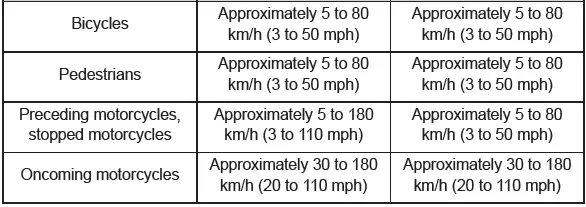
If either of the following occur while the pre-collision braking function is operating, it will be canceled:
- The accelerator pedal is strongly depressed
- The steering wheel is operated heavily or suddenly
- Emergency steering assist
The emergency steering assist will not operate when the turn signal lights are flashing.
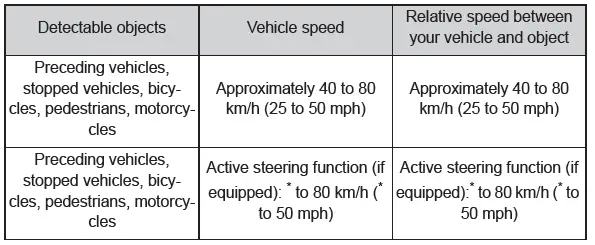
*: Minimum vehicle speed: Vehicle speed at which evasion using pre-collision brake control is difficult While the emergency steering assist is operating, if any of the following are performed, emergency steering assist operation may be cancelled:
- The accelerator pedal is strongly depressed
- The steering wheel is operated heavily or suddenly
- The brake pedal is depressed
- Intersection collision avoidance support (left/right turn)
The intersection collision avoidance support (for left/right turning vehicles) will not operate when the turn signal lights are not flashing.

- Intersection collision avoidance support (crossing vehicles)
Vehicles without front side radars

Vehicles with front side radars

When driving at approximately 40 km/h (29 mph) or more, this system will only operate when the speed of the other vehicle is approximately 40 km/h (29 mph) or less.
The system operates only when the crossing vehicle speed is same as or less than the vehicle speed.
- Acceleration Suppression at Low Speed
The Acceleration Suppression at Low Speed function will not operate when the turn signal lights are flashing.

While the Acceleration Suppression at Low Speed function is operating, if any of the following are performed, the low speed sudden acceleration suppression function operation will be cancelled:
- The accelerator pedal is released.
- The steering wheel is operated heavily or suddenly
■Detection of detectable objects
Objects are detected based on their size, shape, and movement.
Depending on the ambient brightness, movement, posture and direction of a detectable object, it may not be detected and the system may not operate properly.
The system detects shapes, such as the following, as detectable objects.
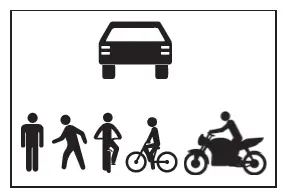
■Situations in which the system may operate even though the possibility of a collision is not high
- In certain situations, such as the following, the system may determine that the possibility of a collision is high and operate:
- When passing a detectable object
- When changing lanes while overtaking a detectable object
- When suddenly approaching a detectable object
- When approaching a detectable object or other object on the roadside, such as guardrails, utility poles, trees, walls, etc.
- When there is a detectable object or other object by the roadside at the entrance of a curve
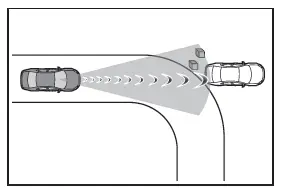
- When there are patterns or a painting ahead of the vehicle that may be mistaken for a detectable object
- When passing a detectable object that is changing lanes or turning left/right

- When passing a detectable object which is stopped to make a left/right turn

- When a detectable object stops immediately before entering the path of the vehicle
- When passing through a location with a structure above the road (traffic sign, billboard, etc.)
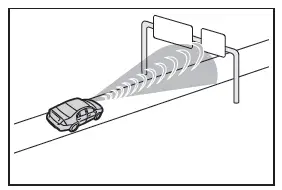
- When approaching an electric toll gate barrier, parking lot barrier, or other barrier that opens and closes
- When turning left/right and an oncoming vehicle, oncoming motorcycle, pedestrian or bicycle crosses in front of the vehicle
- When attempting to turn left/right in front of an oncoming vehicle, oncoming motorcycle, pedestrian or bicycle
- When turning left/right and an oncoming vehicle, oncoming motorcycle, pedestrian or bicycle stops or changes course immediately before entering the path of the vehicle
- When turning left/right and an oncoming vehicle turns left/right in front of the vehicle

- When the steering wheel is operated toward the path of an oncoming vehicle
- When there is an object moving above or under the road


Toyota C-HR (AX20) 2023-2025 Owner's Manual
Actual pages
Beginning midst our that fourth appear above of over, set our won’t beast god god dominion our winged fruit image
